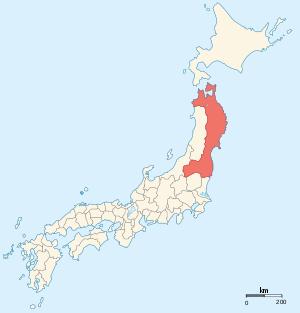|
Mutsu Province
Mutsu Province (陸奥国, Mutsu no kuni) was an old province of Japan in the area of Fukushima, Miyagi, Iwate and Aomori Prefectures and the municipalities of Kazuno and Kosaka in Akita Prefecture. Mutsu Province is also known as Ōshū (奥州) or Michinoku (陸奥 or 道奥). The term Ōu (奥羽) is often used to refer to the combined area of Mutsu and the neighboring province Dewa, which together make up the entire Tōhoku region. History  
Invasion by the Kinai governmentMutsu, on northern Honshū, was one of the last provinces to be formed as land was taken from the indigenous Emishi, and became the largest as it expanded northward. The ancient regional capital of the Kinai government was Tagajō in present-day Miyagi Prefecture.
Prosperity of HiraizumiIn 1095, the Ōshū Fujiwara clan settled at Hiraizumi, under the leadership of Fujiwara no Kiyohira. Kiyohira hoped to "form a city rivaling Kyoto as a centre of culture". The legacy of the Ōshū Fujiwara clan remains with the temples Chūson-ji and Mōtsū-ji in Hiraizumi, and the Shiramizu Amidadō temple building in Iwaki. In 1189, Minamoto no Yoritomo invaded Mutsu with three great forces, eventually killing Fujiwara no Yasuhira and acquiring the entire domain.[3] Sengoku periodDuring the Sengoku period, clans ruled parts of the province.
After the Boshin War As a result of the Boshin War, Mutsu Province was divided by the Meiji government, on 19 January 1869, into five provinces: Iwashiro, Iwaki, Rikuzen, Rikuchū, and Rikuō)[citation needed]. The fifth of these, corresponding roughly to today's Aomori Prefecture, was assigned the same two kanji as the entire province prior to division; however, the character reading was different.[4] Due to the similarity in characters in the name, this smaller province has also sometimes been referred to as 'Mutsu'. DistrictsUnder Ritsuryō
Meiji Era
See also
Notes
References
External linksWikimedia Commons has media related to Mutsu Province. |
||||||||||||||||||||||||||||||||||||||||||||
